Ultrabooks, laptops, and system-in-display computers such as the iMac are popular for a variety of reasons, but a major downside with small, integrated systems is that they are pretty limited in their internal storage options. As such, USB memory sticks and external hard drives are a fairly common supplementary storage for systems like these. The OWC Mercury Elite Pro Qx2 is an external RAID system that allows up to four hard drives to connect directly to a computer via USB2, eSATA, or FireWire.
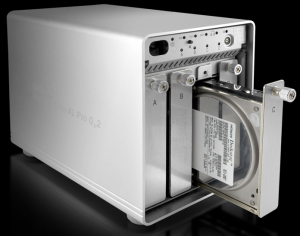 The package includes an eSATA cable (1m), a FireWire 800 cable (6′), a FireWire 400 cable (6′), a USB 2.0 cable (6′), power cable, Intech SpeedTools Utilities (for Mac OS 8.6-X), Prosoft Engineering Data Backup (for OX X 10.2.8+), NovaStor NovaBACKUP (for Windows 2000+), and over 1.5GB of Mac Freeware/Shareware/Public Domain software pre-installed.
The package includes an eSATA cable (1m), a FireWire 800 cable (6′), a FireWire 400 cable (6′), a USB 2.0 cable (6′), power cable, Intech SpeedTools Utilities (for Mac OS 8.6-X), Prosoft Engineering Data Backup (for OX X 10.2.8+), NovaStor NovaBACKUP (for Windows 2000+), and over 1.5GB of Mac Freeware/Shareware/Public Domain software pre-installed.
OWC also separately offers an eSATA->USB 3.0 adapter for $24.99. When purchased along with the Qx2, they provide a $10 instant rebate. The company provided this adapter with the review kit.
Specs and Pricing
| Empty | 2.0TB | 4.0TB | 8.0TB | 12.0TB | 16.0TB | |
|---|---|---|---|---|---|---|
| Price (Consumer) | $259.99 | $471.99 | $549.99 | $719.99 | $894.99 | $1419.99 |
| Price (Enterprise) | $259.99 | N/A | 759.99 | $1079.99 | $1924.99 | $2759.99 |
| Drive configuration | none | 4x500GB | 4x1TB | 4x2TB | 4x3TB | 4x4TB |
| Drive Rotation & Cache | 7200RPM, 128MB | 7200RPM, 256MB | ||||
| Ports | 2x FireWire 800, 1x FireWire 400, 1x USB 2.0, 1x eSATA | |||||
| RAID Support | Span, 0, 1, 5, 10 | |||||
| Warranty (consumer) | 1 year | 3 Years | ||||
| Warranty (enterprise) | 1 year | 5 Years | ||||
OWC lists the cache as the combined total of all four included hard drives. Our review unit is the 2TB version comprised of four Toshiba 500GB 7200RPM drives with a 32MB cache.
The Qx2 comes preformatted for HFS+, the Mac OS file system. Windows users can download Apple’s Boot Camp drivers for Windows (free) to access the initial file system, which could come in handy since the backup utilities and 1.5GB of pre-installed software are provided on the Qx2’s HFS+ volume.
RAID Options
The Qx2 provides two options for storage: SPAN and RAID. Its span mode uses the first drive’s capacity completely, then moves to the second drive, and so on until all drives are full. While you’re limited to the speed of a single drive at any given time, there are two possible benefits. The first is you don’t have to have all bays filled from the start; a single drive can be installed and when it approaches 100% capacity another drive can be added. The other is the ability to use different sized drives.
RAID options are the same as most motherboards: RAID-0 stripes data across two or four drives, but if one drive goes out the whole array is lost. RAID-1 (only available with two drives on the Qx2) mirrors data on each drive, so one drive failing doesn’t result in a loss of data. RAID-10 is a combination of both RAID-0 and -1. Data is striped across two drives, and the stripes are mirrored onto the other two drives, allowing the failure of up to two drives before data is lost; opposite stripe drives on the mirrors can fail without data loss but if the same stripe drives were to fail the data will be lost. RAID-5 stripes the data across 3-4 drives and includes parity calculations for the data—data and parity calculations are distributed across the disks.
Available capacity and speed depends on your choice of drive layout and we’ll use the review unit’s four 500GB drives as an example. Spanning provides the total capacity of all four drives (2TB in the case of our review unit), but again only runs at the speed of a single drive. RAID-0 also provides the capacity of all four drives (2TB), but in theory provides four times the read and write speed of a single drive. RAID-1 isn’t available for four drives in the Qx2—a two drive configuration would see single drive capacity and write speed, but twice the read speed of a single drive. RAID-10 provides the capacity of half the drives (1TB), four times the read speed of a single drive, and twice the write speed of a single drive. RAID-5 uses the formula (n-1)X for all of its calculations, so assuming all four bays are occupied we get the capacity (1.5TB), read, and write speeds of three drives.
Pricing vs Capacity
The Qx2 as an empty NAS is among the least expensive units in this category—though, based on some quick spot checking on Newegg, the story changes somewhat when storage is included. The 2TB and 4TB SKUs cost nearly the same as purchasing the empty unit and four similarly specced hard drives at $479 ($+8) and $535 ($+14), respectively. Moving up to 8TB and 12TB produce the largest price gaps at $619 ($+100) and $779 ($+115). At the largest capacity of 16TB the price delta actually favors the Qx2 at $1459 ($-40).
I’d say it’s fair to call the pricing difference the cost of an extended warranty, since a Qx2 with drives gets a much longer warranty period than the empty unit.
Performance
The OWC Mercury Elite Pro Ox2 was tested in all of its four-drive RAID configurations: 0 (striping), 10 (mirrored striping), and 5 (striping with parity). USB 2.0, 3.0, and eSATA interfaces were tested. FireWire 400 and 800 were not tested due to a lack of equipment.
Testing showed nearly identical performance regardless of RAID configuration, so one set of read/write numbers will be provided for each interface.
ATTO
It turns out that it doesn’t matter whether you’re using eSATA 3.0Gbps or 6.0Gbps on the Qx2—the performance tops out around 260MB/s on both interfaces for read and write. In fact, these speeds are comparable to a typical SATA 3.0Gbps SSD. USB 3.0 provides a respectable 190MB/s for both read and write. USB2.0 naturally comes in as the slowest interface with just under 35MB/s for reads and 28MB/s for writes.
Since the Qx2 is equipped with hard drives, we’ll skip the rest of the usual SSD-centered benchmarks and move on to the real-world transfer testing.
File transfer
Two sets of data were used: a 9GB mix of 7,661 files of varying types and sizes, and a 15GB set of 14 media files of similar size.
 As with the previous test, eSATA maintains the lead spot among our tested interfaces, with USB 3.0 trailing by a bit. One oddity is in the large file write test—USB 3.0 is significantly faster than eSATA. I don’t have an explanation for it either; the test was run multiple times and each time the results were the same.
As with the previous test, eSATA maintains the lead spot among our tested interfaces, with USB 3.0 trailing by a bit. One oddity is in the large file write test—USB 3.0 is significantly faster than eSATA. I don’t have an explanation for it either; the test was run multiple times and each time the results were the same.
Overall, the OWC Mercury Elite Pro Qx2 offers a good price, excellent performance, and a wide range of storage options, and is awarded the Icrontic Stamp of Approval. You can pick up the OWC Mercury Elite Pro QX2 directly from Other World Computing.


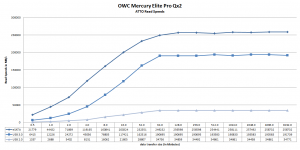
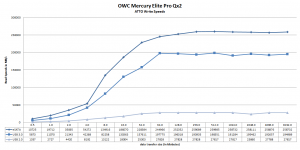
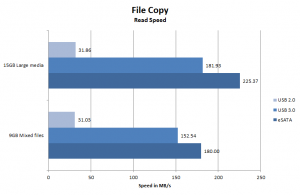
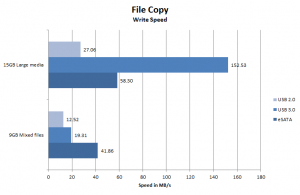





 Articles RSS
Articles RSS